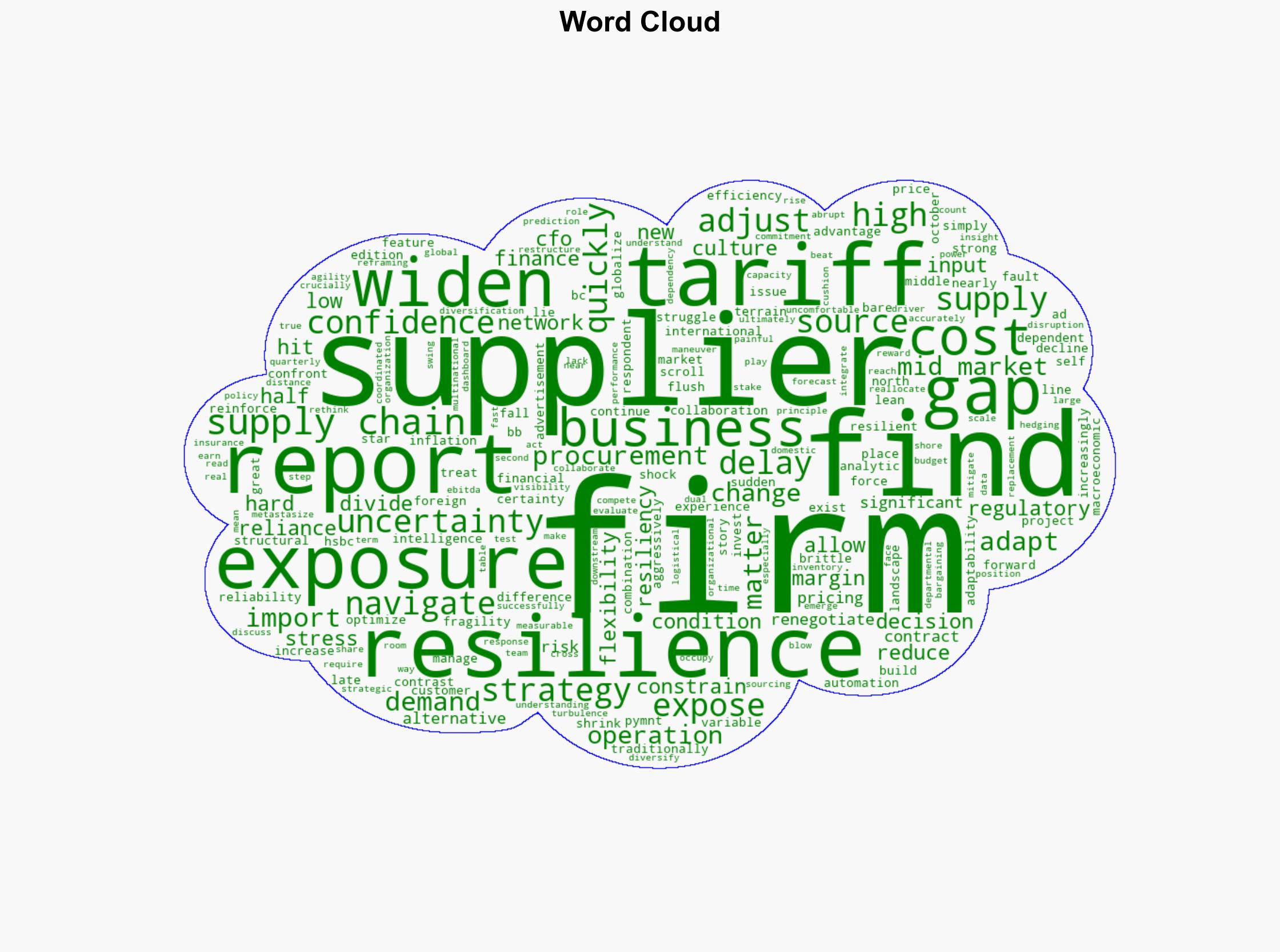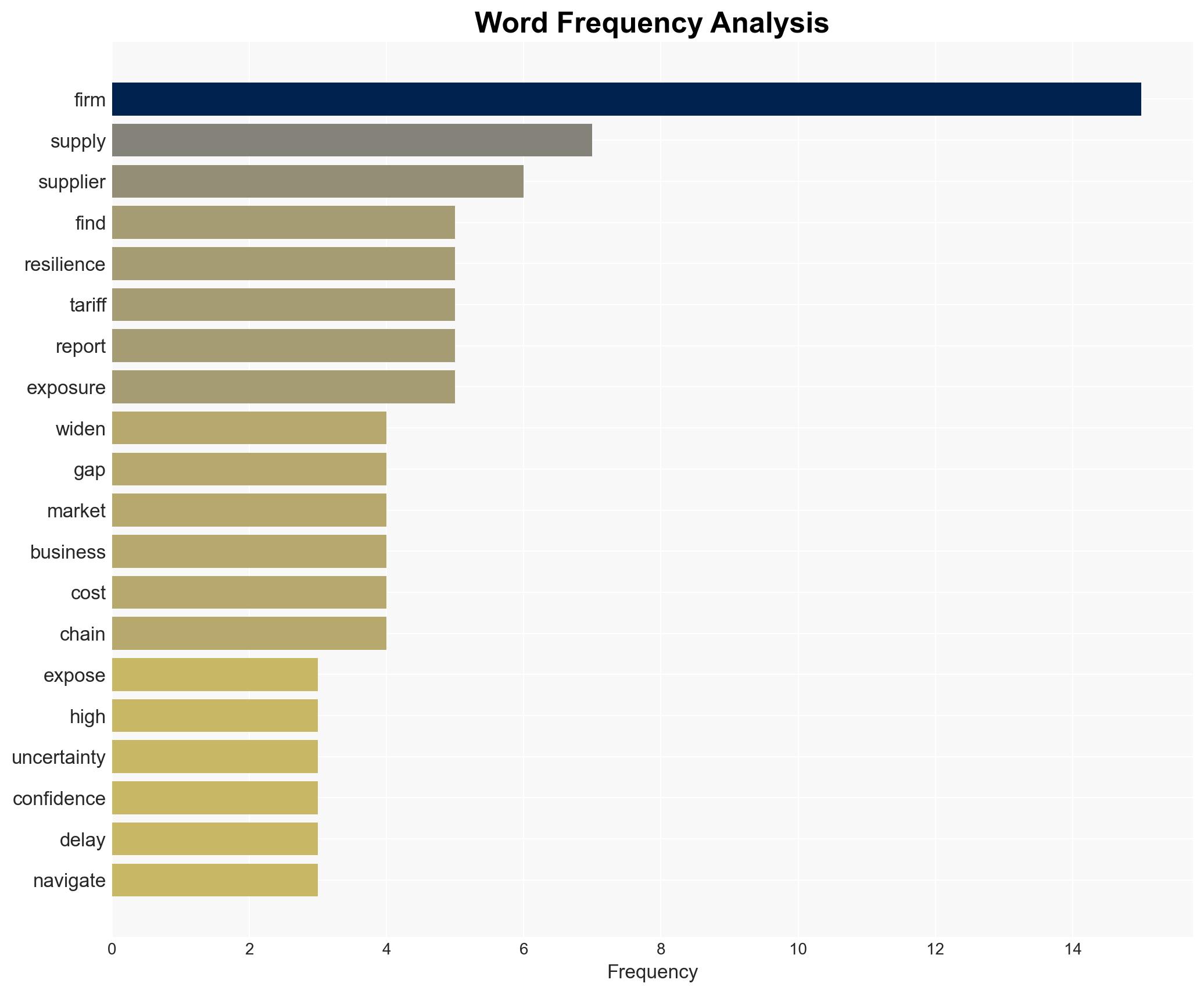Tariffs Expose Growing Resiliency Divide Across Mid-Market Supply Chains – pymnts.com
Published on: 2025-11-14
AI-powered OSINT brief from verified open sources. Automated NLP signal extraction with human verification. See our Methodology and Why WorldWideWatchers.
Intelligence Report: Tariffs Expose Growing Resiliency Divide Across Mid-Market Supply Chains – pymnts.com
1. BLUF (Bottom Line Up Front)
The strategic analysis indicates a growing divide in resiliency among mid-market firms due to tariffs, with firms heavily reliant on international suppliers facing significant challenges. The most supported hypothesis is that firms with diversified supply networks and strong data visibility are better positioned to manage tariff-induced disruptions. Confidence Level: Moderate. Recommended action includes enhancing supply chain diversification and improving data analytics capabilities to mitigate risks.
2. Competing Hypotheses
Hypothesis 1: Firms with high reliance on international suppliers are more vulnerable to tariffs, leading to increased costs, delays, and reduced reliability, thus widening the resiliency gap.
Hypothesis 2: Firms with diversified supply networks and robust data visibility can effectively manage tariff impacts, maintaining operational stability and competitive advantage.
The evidence supports Hypothesis 2 as more likely, given the emphasis on diversification and data visibility as key factors in navigating tariff-induced disruptions. Firms that have invested in these areas report fewer issues and greater adaptability.
3. Key Assumptions and Red Flags
Assumptions: The analysis assumes that tariffs will continue to impact global supply chains and that firms have the capability to diversify and enhance data visibility.
Red Flags: Potential bias in reporting from firms that have successfully adapted, possibly underreporting challenges. Limited data on firms unable to adapt may skew the perceived effectiveness of diversification strategies.
4. Implications and Strategic Risks
The primary risk is economic, with mid-market firms facing increased input costs and reduced margins. Politically, continued tariff policies could exacerbate tensions between trading partners. Firms unable to adapt may face insolvency, leading to job losses and regional economic downturns. Cyber risks may increase as firms adopt new technologies for supply chain management without adequate cybersecurity measures.
5. Recommendations and Outlook
- Enhance supply chain diversification by identifying alternative suppliers and considering near-shoring or dual-sourcing strategies.
- Invest in data analytics to improve real-time visibility into supply chain performance and cost drivers.
- Foster a culture of agility and collaboration across procurement, finance, and operations to enable rapid adaptation to changing conditions.
- Best-case scenario: Firms successfully diversify and leverage data analytics, maintaining competitive advantage and operational stability.
- Worst-case scenario: Firms fail to adapt, leading to significant financial losses and potential insolvency.
- Most-likely scenario: A mixed outcome where some firms adapt successfully while others struggle, leading to a continued divide in resiliency.
6. Key Individuals and Entities
No specific individuals are mentioned in the source text. Key entities include mid-market firms, international suppliers, and regulatory bodies impacting tariff policies.
7. Thematic Tags
Cybersecurity, Supply Chain Resilience, Tariffs, Economic Impact, Data Analytics, Diversification Strategy, Mid-Market Firms
Structured Analytic Techniques Applied
- Adversarial Threat Simulation: Model and simulate actions of cyber adversaries to anticipate vulnerabilities and improve resilience.
- Indicators Development: Detect and monitor behavioral or technical anomalies across systems for early threat detection.
- Bayesian Scenario Modeling: Quantify uncertainty and predict cyberattack pathways using probabilistic inference.
- Network Influence Mapping: Map influence relationships to assess actor impact.
Explore more:
Cybersecurity Briefs ·
Daily Summary ·
Support us
·





